AWM41 994 - [Nurses Narratives] Annie Lardi
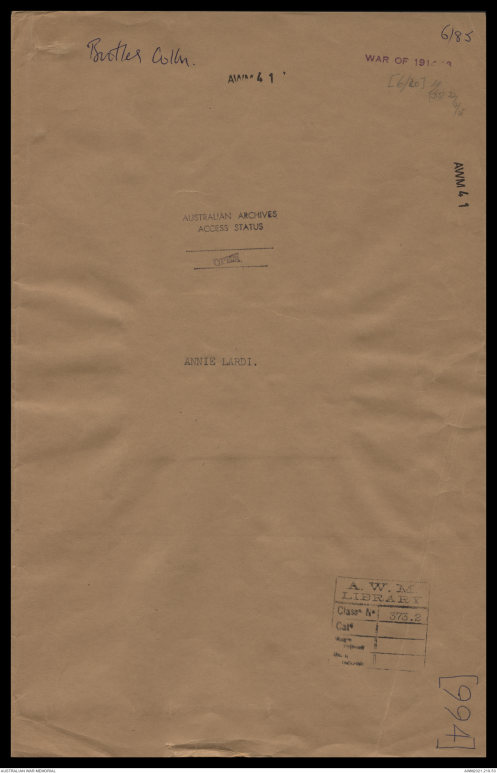

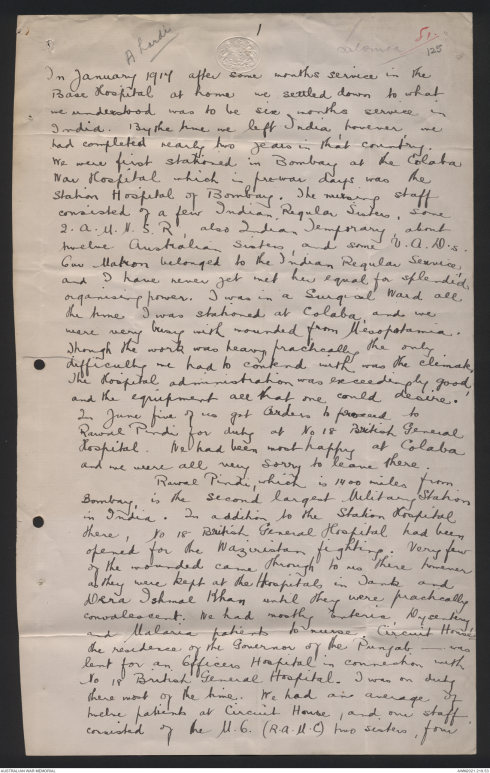
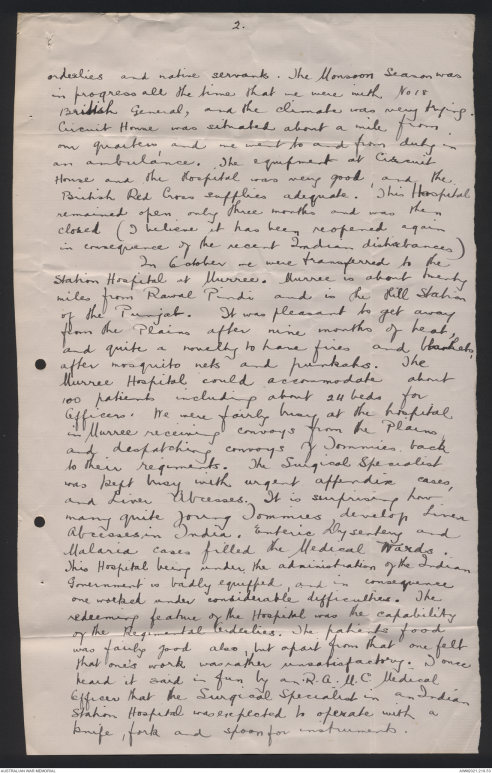
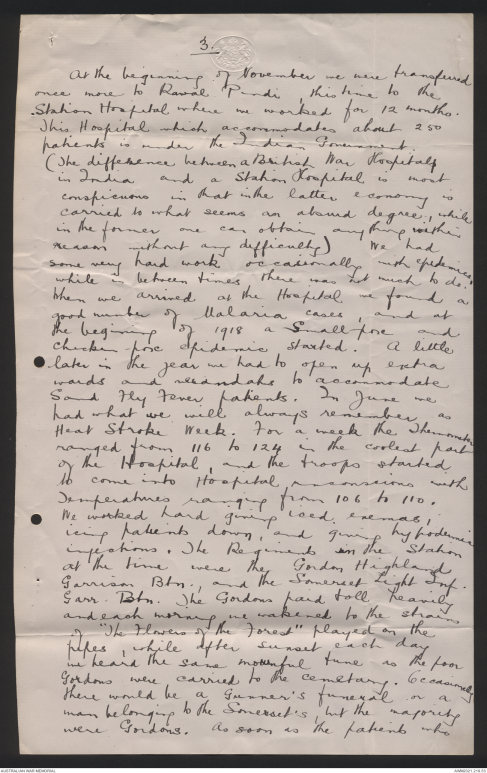
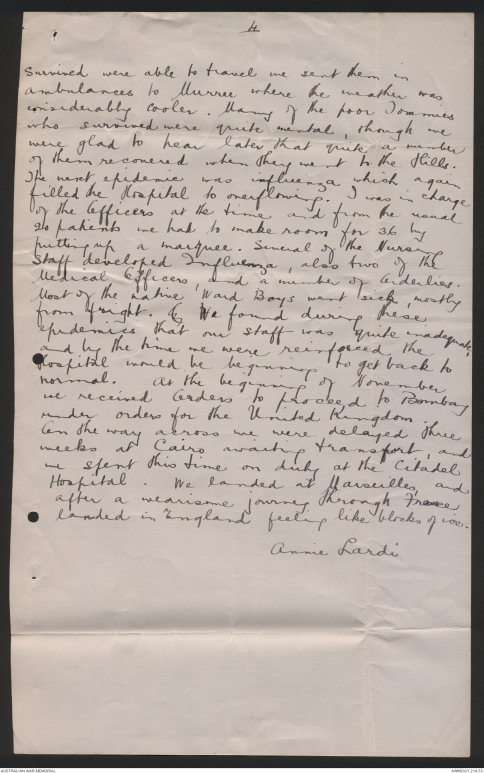
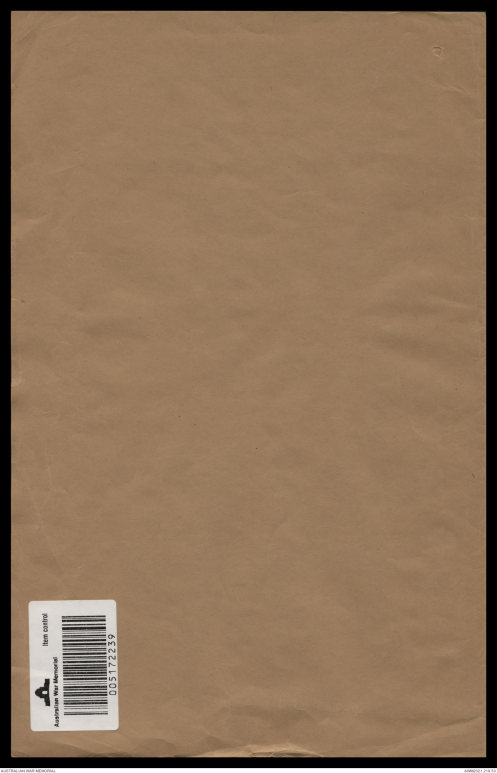
6/85
Butler Colln.
WAR OF 19[?]
AWM 41
6/20 [?]
AUSTRALIAN ARCHIVES
ACCESS STATUS
OPEN
ANNIE LARDI
AWM 41
A.W.M LIBRARY
Classn No 373.2
[994]
The Official War Historian of the Commonwealth
Government (Dr. C. E. W. Bean), after his study of the
collection of private war records preserved in the Australian
War Memorial Library, wrote:
"The private diaries in this collection furnish some of its most
valuable historical records, but, like all private memoirs which were
not compiled with any historical purpose, they should not be
regarded as first-hand evidence except where it is certain that they
are so. The diarist is almost always sincere in his desire to record
accurately, but he is subject to no obligation or inducement to
indicate whether he is recording his own observations or incidents
told him by friends or heard as third or fourth hand at the mess-table.
Thus, in some of the diaries in this collection, scenes described with
vivid detail and without any warning that they are told at second
or third hand have been found to be completely inaccurate in
important details. A certain number also have been written up
or revised long after the events, though doubtless usually from notes
made at the time. In most cases the student must rely on his
experiences and on internal evidence to guide him in judging what is
and what is not likely to be historically accurate."
1
A Lardi Salonica 51/125
In January 1917 after some months service in the
Base Hospital at home we settled down to what
we understood was to be six months service in
India. By the time we left India, however we
had completed nearly two years in that country.
We were first stationed in Bombay at the Colaba
War Hospital which in prewar days was the
Station Hospital of Bombay. The nursing staff
consisted of a few Indian Regular Sisters, some
2. A.U.N.S.R, also Indian Temporary about
twelve Australian Sisters, and some V.A.D.s.
Our Matron belonged to the Indian Regular Service
and I have never get met her equal for splendid,
organising power. I was in a Surgical Ward all
the time I was stationed at Colaba, and we
were very busy with wounded from Mesopotamia.
Though the work was heavy practically the only
difficulty we had to contend with was the climate.
The Hospital administration was exceedingly good
and the equipment all that one could desire.
In June five of us got orders to proceed to
Rawal Pindi for duty at No 18 British General
Hospital. We had been most happy at Colaba
and we were all very sorry to leave there.
Rawal Pindi, which is 1400 miles from
Bombay, is the second largest Military Station
in India. In addition to the the Station Hospital
there, No 18 British General Hospital had been
opened for the Waziristan fighting. Very few
of the wounded came through to us there however
as they were kept at the Hospitals in Jank and
Dera Ishmal Khan until they were practically
convalescent. We had mostly bacteria, Dysentery
and Malaria patients to nurse. Circuit House
the residence of the Governor of Punjab - was
lent for an Officers Hospital in connection with
No 18 British General Hospital. I was on duty
there most of the time. We had an average of
twelve patients at Circuit House, and our staff
consisted of the M.O. (R.A.M.C) two sisters, four
2.
orderlies and native servants. The Monsoon Season was
in progress all the time that we were with No 18
British General, and the climate was very trying.
Circuit House was situated about a mile from
our quarters and we went to and from duty in
an ambulance. The equipment at Circuit
House and the Hospital was very good, and the
British Red Cross supplies adequate. This Hospital
remained open only three months and was then
closed (I believe it has been reopened again
in consequence of the recent Indian disturbances)
In October we were transferred to the
Station Hospital at Murree. Murree is about twenty
miles from Rawal Pindi and is the Hill Station
of the Punjab. It was pleasant to get away
from the Plains after nine months of heat,
and quite a novelty to have fires and blankets,
after mosquito nets and punkahs. The
Murree Hospital could accommodate about
100 patients including about 24 beds for
Officers. We were fairly busy at the hospital
in Murree receiving convoys from the Plains
and despatching convoys of Tommies back
to their regiments. The Surgical Specialist
was kept busy with urgent appendix cases,
and Liver Abcesses. It is surprising how
many quite young Tommies develop Liver
Abcesses in India. Enteric Dysentery and
Malaria cases filled the Medical Wards.
This Hospital being under the administration of the Indian
Government is badly equipped , and in consequence
one worked under considerable difficulties. The
redeeming feature of the Hospital was the capability
of the Regimental Orderlies. The patients food
was fairly good also, but apart from that one felt
that one's work was rather unsatisfactory. I once
heard it said in fun by an. R.A.M.C Medical
Officer that the Surgical Specialist in an Indian
Station Hospital was expected to operate with a
knife, fork and spoon for instruments.
3.
At the beginning of November we were transferred
once more to Rawal Pindi, this time to the
Station Hospital where we worked for 12 months.
This Hospital which accommodates about 250
patients is under the Indian Government.
(The difference between a British War Hospitals
in India and a Station Hospital is most
conspicuous in that in the latter economy is
carried to what seems an absurd degree, while
in the former one can obtain anything within
reason without any difficulty) We had
some very hard work occasionally with epidemics,
while in between times there was not much to do.
When we arrived at the Hospital we found a
good number of Malaria cases, and at
the beginning of 1918 a Smallpox and
chicken pox epidemic started. A little
later in the year we had to open up extra
wards and verandahs to accommodate
Sand Fly Fever patients. In June we
had what we will always remember as
Heat Stroke Week. For a week the thermometer
ranged form 116 to 124 in the coolest part
part of the Hospital, and the troops started
to come into Hospital unconscious with
temperatures ranging form 106 to 110.
We worked hard giving iced enemas,
icing patients down, and giving hypodermic
injections. The Regiments in the Station
at the time were the Gordon Highland
Garrison Btn., and the Somerset Light Inf.
Garr. Btn. The Gordons paid toll heavily
and each morning we wakened to the strains
of "The Flowers of the Forest" played on the
pipes, while after sunset each day
we heard the same mournful tune as the poor
Gordons were carried to the cemetary. Occasionally
there would be a Gunner's funeral or a
man belonging to the Somerset's, but the majority
were Gordons. As soon as the patients who
4.
survived were able to travel we sent them in
ambulances to Murree where the weather was
considerably cooler. Many of the poor Tommies
who survived were quite mental, though we
were glad to hear later that quite a number
of them recovered when they went to the Hills.
The next epidemic was influenza which again
filled the Hospital to overflowing. I was in charge
of the Officers at the time and from the usual
20 patients we had to make room for 36 by
putting up a marquee. Several of the Nursing
Staff developed Influenza, also two of the
Medical Officers, and a number of the Orderlies.
Most of the native Ward Boys went sick, mostly
from fright. ( We found during these
epidemics the our staff was quite inadequate,
and by the time we were reinforced the
Hospital would be beginning to get back to
normal. At the beginning of November
we received orders to proceed to Bombay
under orders for the United Kingdom.
On the way across we were delayed three
weeks at Cairo awaiting transport, and
we spent this time on duty at the Citadel
Hospital. We landed at Marseilles, and
after a wearisome journey through France
landed in England feeling like blocks of ice.
Annie Lardi
Item Control
Australian War Memorial
005172239
 Sam scott
Sam scottThis transcription item is now locked to you for editing. To release the lock either Save your changes or Cancel.
This lock will be automatically released after 60 minutes of inactivity.